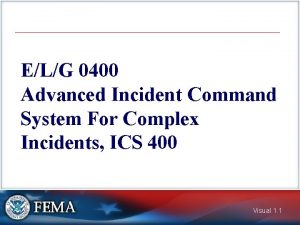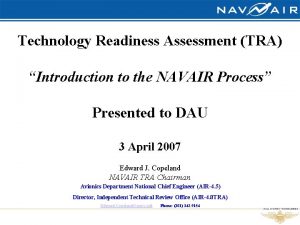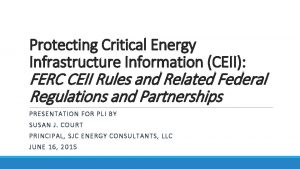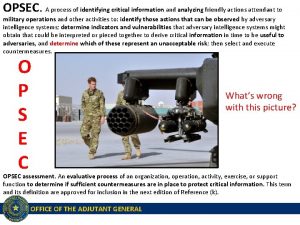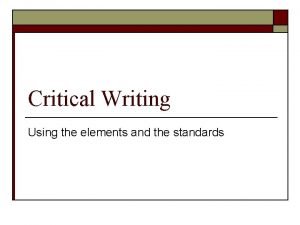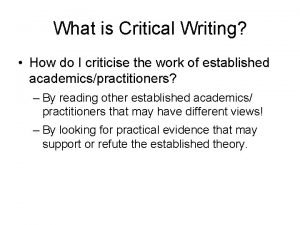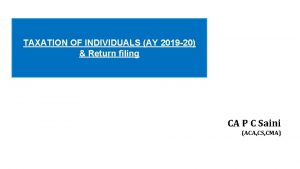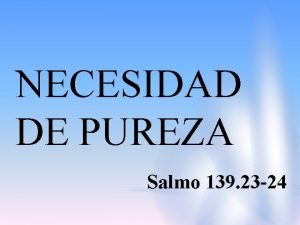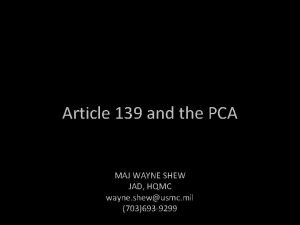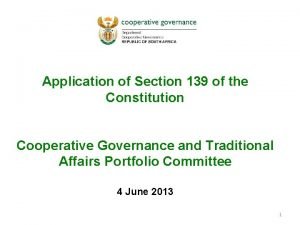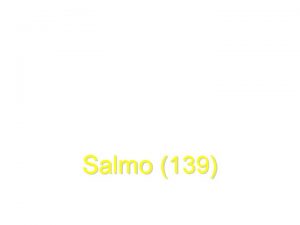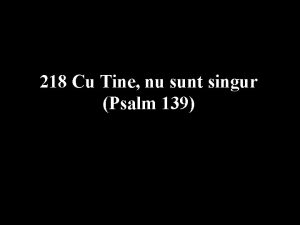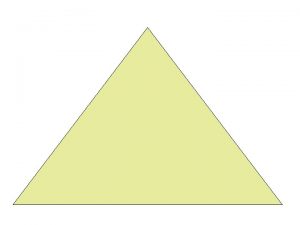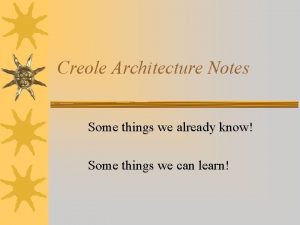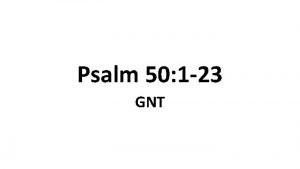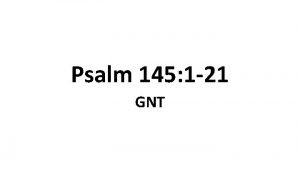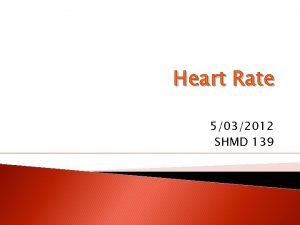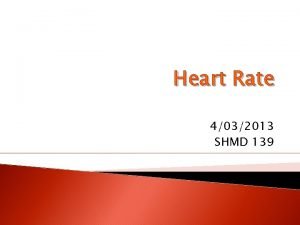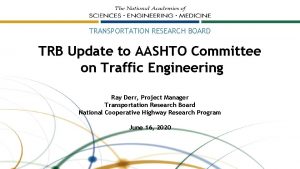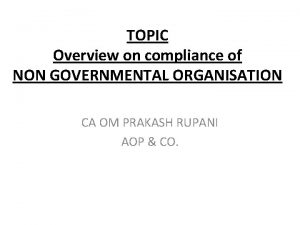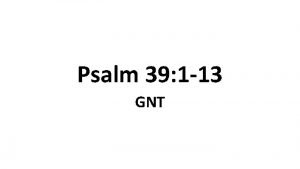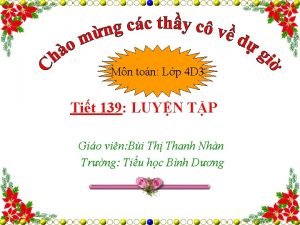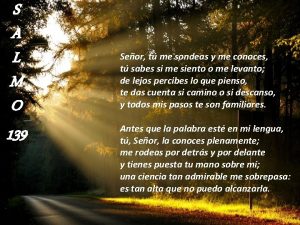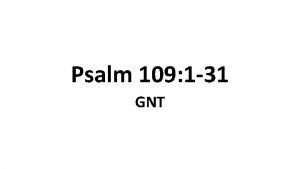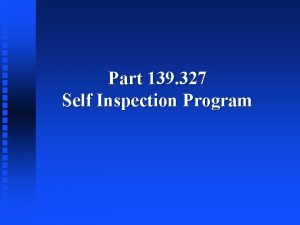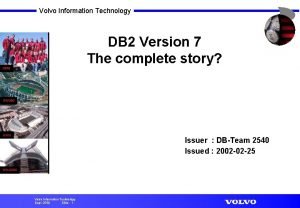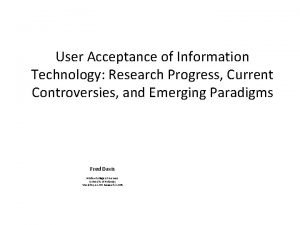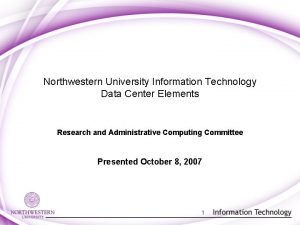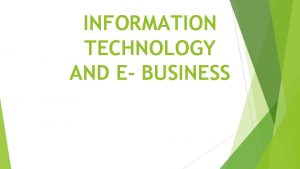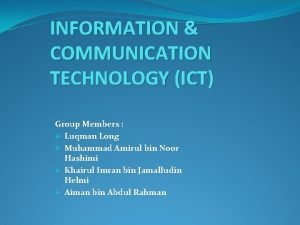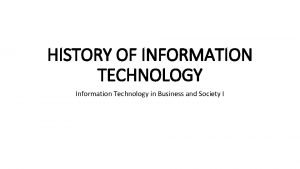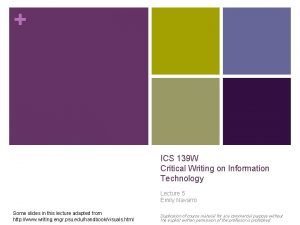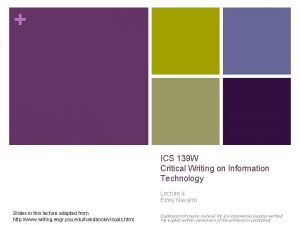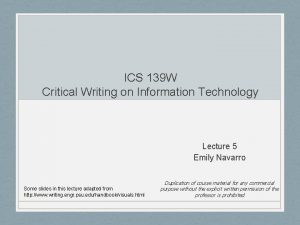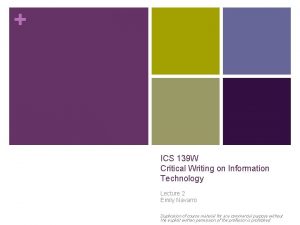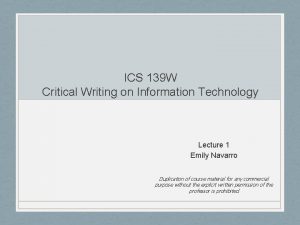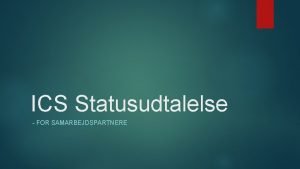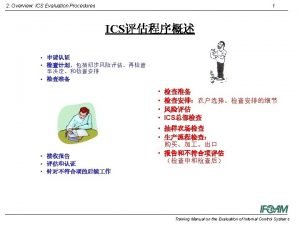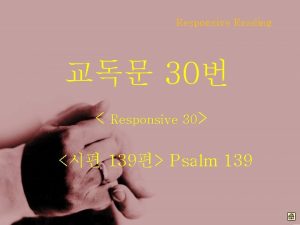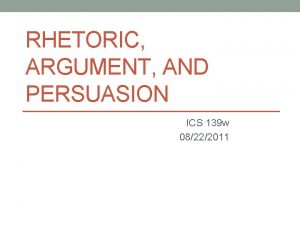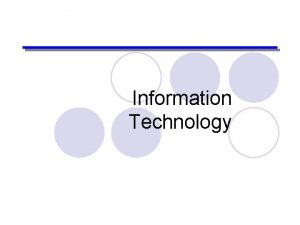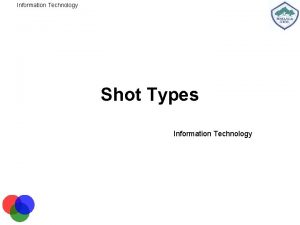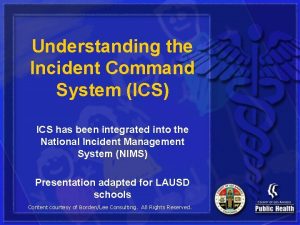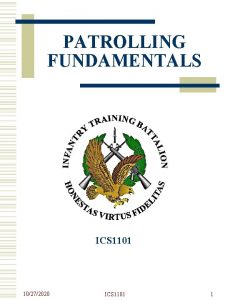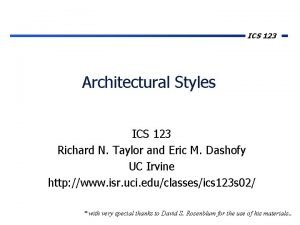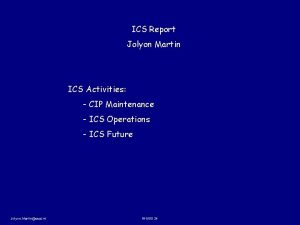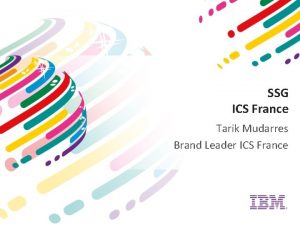ICS 139 W Critical Writing on Information Technology

















































- Slides: 49

ICS 139 W Critical Writing on Information Technology Lecture 3 Emily Navarro Some slides in this lecture adapted from http: //www. writing. engr. psu. edu/handbook/visuals. html Duplication of course material for any commercial purpose without the explicit written permission of the professor is prohibited

Today’s Lecture • Three Laws of Professional Communication • Typography • Illustration/Data visualization

Three Laws of Professional Communication • Doumont, J-L. (2002). The three laws of professional communication. Professional Communication, IEEE Transactions on, 45(4), 291 -296

Three Laws of Robotics (Asimov) First law A robot may not injure a human being, or, through inaction, allow a human being to come to harm Second law A robot must obey the orders given it by human beings except where such orders would conflict with the first law Third law A robot must protect its own existence as long as such protection does not conflict with the first or second laws

Three Laws of Thermodynamics First law Energy can transform, but cannot be created or destroyed. Second law The entropy of a closed system always increases in time. Third law By no finite series of processes is the absolute zero attainable

Three Laws of Professional Communication 1. Adapt to your audience 2. Maximize the signal/noise ratio 3. Use effective redundancy *Three laws apply to both spoke and written communication

Premise: Optimize Under Constraints • Get your audience to: • pay attention to, • understand, • (be able to) act upon • a maximum of message(s), given constraints

Law 1: Adapt to Your Audience

Law 2: Maximize the Signalto-Noise Ratio

“Noise” in Oral Communication • Room noise • Audience • Environment • Slides • Distracting visual aids • Speaker • Distracting behavior

“Noise” in Written Communication • Text • Mechanical errors • Page layout • Structure issues • Typography issues • Illustrations • Confusing issues • Inappropriate detail

Law 3: Use Effective Redundancy

Effective Redundancy for Oral Communication • Preview and review on slides • Same messages are spoken by speaker and illustrated by slides

Effective Redundancy for Written Communication • Use of an abstract or executive summary • Use of figures that illustrate textual messages • Section headings • Email subject headings

Zeroth Law of Communication • Systems of laws often evolve a “zeroth law, ” capturing an obvious or implicit premise • Zeroth law of robotics: A robot may not injure humanity, or, through inaction, allow humanity to come to harm. • Zeroth law of thermodynamics: Two systems in thermal equilibrium with a third are in thermal equilibrium with each other. • Zeroth law of professional communication: Define your purpose.

Zeroth Law of Communication • Systems of laws often evolve a “zeroth law, ” capturing an obvious or implicit premise • Zeroth law of robotics: A robot may not injure humanity, or, through inaction, allow humanity to come to harm. • Zeroth law of thermodynamics: Two systems in thermal equilibrium with a third are in thermal equilibrium with each other. • Zeroth law of professional communication: Define your purpose. Have a message!

Typography

Why learn about typography? • Small differences in readability make large differences in effectiveness • Typographic research has yielded several wellestablished rules of typography

Typography: Basic Principle • Good typography helps the reader distinguish among different • • • letters words lines paragraphs sections

Typefaces • Use typefaces with • proportional spacing (rather than monospace) • varying stroke widths (? ) Thin stroke • serifs (? ) Serif Like this Thick stroke • This font is monospace, has uniform stroke widths, and no serifs.

Sans serifs are making a comeback http: //mashable. com/2015/09/02/google-sans-seriflogos/#w. W 3 TH 8 d. Lq. Sqr

Another Trend: Font Readability on Mobile Devices San Francisco (new) Helvetica (old)


Avoid large blocks of capital letters TYPE IS TO READ Type is to read WORDS SET IN ALL CAPS USE MORE SPACE THAN TEXT SET IN LOWERCASE. Words set in all caps use more space than words set in lowercase.

PRIMARY CONCERNS FIELD JOINT - HIGHEST CONCERN • EROSION PENETRATION OF PRIMARY SEAL REQUIRES RELIABLE SECONDARY SEAL FOR PRESSURE INTEGRITY • IGNITION TRANSIENT - (0 -600 MS) • (0 -170 MS) HIGH PROBABILITY OF RELIABLE SECONDARY SEAL • (170 -330 MS) REDUCED PROBABILITY OF RELIABLE SECONDARY SEAL • (330 -600 MS) HIGH PROBABILITY OF NO SECONDARY SEAL CAPABILITY • STEADY STATE - (600 MS - 2 MINUTES) • IF EROSION PENETRATES PRIMARY O-RING SEAL - HIGH PROBABILITY OF NO SECONDARY SEAL CAPABILITY • BENCH TESTING SHOWED O-RING NOT CAPABLE OF MAINTAINING CONTACT WITH METAL PARTS GAP OPERATING TO MEOP Morton-Thiokol Presentation to NASA • BENCH TESTING SHOWED CAPABILITY TO MAINTAIN O-RING January 27, 1986 CONTACT DURING INITIAL PHASE (0 - 170 MS) OF TRANSIENT

Primary Concerns Field Joint - Highest Concern • Erosion penetration of primary seal requires reliable secondary seal for pressure integrity • Ignition transient - (0 -600 MS) • (0 -170 MS) High probability of reliable secondary seal • (170 -330 MS) Reduced probability of reliable secondary seal • (330 -600 MS) High probability of no secondary seal capability • Steady State - (600 MS - 2 MINUTES) • If erosion penetrates primary O-ring seal – high probability of no secondary seal capability • Bench testing showed O-ring not capable of maintaining contact with metal parts gap operating to meop Morton-Thiokol Presentation NASA • Bench testing showed capability to maintain O-ring contact toduring January 27, 1986 initial phase (0 – 170 MS) of transient

Choose a type size that is easy to read 48 point 36 point posters presentation slides 24 point 18 point 14 point titles 12 point 10 point 8 point text footnotes

Use white space for association, emphasis, and hierarchy space for headings space for margins space for illustrations

Follow the format that is expected or required for the situation

Illustration/Data Visualization

Two types of illustrations exist: tables and figures Table 1. Reactor power levels in Chernobyl accident [Wolfson, 1991]. Pressurizer Date Time Power Level 4/25 1: 00 am 3200 MW 4/25 2: 00 pm 1600 MW 4/25 11: 10 pm 1600 MW 4/26 1: 00 am 30 MW 4/26 1: 19 am 200 MW 4/26 1: 23 am 2, 000 MW Coolant Loss Reactor Vessel Steam Generator Core Figure 1. Simplified diagram of nuclear reactor [Wolfson, 1991].

Tables can present words as well as numbers Table 2. Sequence of events in the Chernobyl accident [Wolfson, 1991]. Date Time Power Level Event April 25 1: 00 a. m. 3200 MW Operators begin power descent April 25 2: 00 p. m. 1600 MW Power descent delayed for 9 hours Emergency core-cooling system disconnected April 25 11: 10 p. m. 1600 MW Operators switch off automatic control Power descent resumed April 26 1: 00 a. m. 30 MW 1: 19 a. m. 200 MW 1: 23 a. m. 2, 000 MW Power minimum reached April 26 Operators pull rods beyond allowable limits Operators start two additional coolant pumps Operators violate coolant flow limits April 26 Power surges by factor of 10, 000 in 5 seconds

When presenting numerical data, you choose between tables and graphs Table 2. Blood glucose levels [Carlson, 1982]. 300 Breakfast Lunch Dinner 250 Time (hour) Normal (mg/dl*) Diabetic (mg/dl) midnight 2: 00 4: 00 6: 00 8: 00 10: 00 noon 2: 00 4: 00 6: 00 8: 00 100. 3 93. 6 88. 2 100. 5 138. 6 102. 4 93. 8 132. 3 103. 8 93. 6 127. 8 109. 2 175. 8 165. 7 159. 4 72. 1 271. 0 224. 6 161. 8 242. 7 219. 4 152. 6 227. 1 221. 3 * decaliters/milligram Diabetic Blood Glucose Level (mg/dl) 200 150 100 Normal 50 0 12: 00 6: 00 am 12: 00 6: 00 pm 12: 00 Hour Figure 11. Blood glucose levels for normal individual and diabetic [Carlson, 1982].

Line graphs are common in engineering and science 2000 1500 Temperature (K) 1000 500 Experiment Simulation 0 0 2 4 6 8 10 Distance From Burner (mm) Figure 3. Computational and experimental temperatures for laminar diffusion flames [Sandia, 1987].

Bar graphs compare wholes 30 Normal range 20 7 -10 Cells% 10 112– 175 211– 366 Flight Duration (Days) Figure 4. Response of T-cells in cosmonauts after short-term and long-term flights [Konstantinova, 1991].

Gantt charts are a type of bar charts Task 1979 1981 1983 1985 1987 1989 Construction Test and Evaluation Power Production Figure 5. Schedule for the construction, evaluation, and production phases of the Solar One Power Plant.

Pie graphs compare parts of a whole Medical and research wastes Government wastes (16%) (2%) Industrial wastes (28%) Power Reactor Industrial Medical nt Gov ernme Power reactor wastes (64%) Figure 5. Volume of low-level nuclear wastes from various sources [League, 1985].

Graphs come in many forms Average dose: 160 mrem 85 mrem Natural Sources 70 mrem Medical Sources { Fallout: < 3 mrem Occupational: < 1 mrem Nuclear power: < 1 mrem Figure 6. Estimated annual dose of radiation in the United States [GPU Nuclear, 1985].

When presenting images, you choose between photographs, drawings, and diagrams

The main advantage of photographs is realism 60 seconds 59. 5 seconds 59 seconds Figure 2. Space Shuttle Challenger, from about 59 seconds to 60 seconds into launch (January 28, 1986). On the right rocket, flame first becomes visible and then impinges on tank.

One advantage of drawings is control of detail Combustor Simulator Turbine Vanes Secondary Flow Primary Flow Secondary Flow Dilution Jet Film-Cooling Holes

The main advantage of a diagram is the ability to show flow of a variable through a system Figure 8. Flow of Information Through the Parts of a von Neumann Machine

Scientists and engineers often use illustrations that are too complex for the text The thermal storage system stores heat in a huge, steelwalled tank. Steam from the solar receiver passes through heat exchangers to heat thermal oil, which is pumped into the tank. The tank then provides energy to run a steam generator to produce electricity. A schematic of this system is shown in Figure 5. RECEIVER DSPH TSH FLASH TANK TSU FT DEARATOR HP HTR Figure 5. Schematic of thermal storage system. TURBINE HOT WELL T S S G

The precision of the illustrations should reflect the precision of the text The thermal storage system, shown in Figure 6, stores heat in a huge, steel-walled tank. Steam from the solar receiver heats a thermal oil, which is pumped into the tank. The tank then provides energy to run a steam generator to produce electricity. 650°F solar receiver 435°F 580°F Thermal Tank Heat Exchanger 425°F 530°F 575°F Heat Exchanger 425°F Figure 6. Schematic of thermal storage system for the solar power plant. steam generator 250°F

For clarity, you should introduce and explain illustrations in the text . . . , as shown in Figure 7…. Figure 7. Title of figure. Some formats allow you extra sentences to explain unusual details.

Inconsistencies between text and images disrupt fluidity The testing hardware of the rocket shown in Figure 8 has five main components: camera, digitizer, computer, I/O interface, and mechanical interface. Commands are generated by the computer, then passed through the I/O interface to the mechanized interface where the keyboard of the ICU is operated. The display of the ICU is read with a television camera and then digitized. This information is then manipulated by the computer to direct the next command. CONTROL TERMINAL PRINTER CAMERA DIGITIZER ROCKET COMPUTER ELECTROMECHANICAL INTERFACE Figure 8. Testing hardware.

Illustration is the meshing of words with images Our system for testing the launch controls of the rocket consists of four main parts: computer, electro-mechanical interface, camera, and digitizer. In this system (shown in Figure 9), the computer generates test commands to the rocket through the electro-mechanical interface. The test results are read with a television camera, and then digitized. The computer receives the information from the digitizer, and then directs the next test command. 1 Computer 4 Digitizer 2 Electro. Mechanical Interface 3 Camera Figure 9. System to test launch controls for rocket. Rocket

Summary – Three Laws 1. Adapt to your audience 2. Maximize the signal/noise ratio 3. Use effective redundancy

Summary – Typography/Illustration • Good typography helps readers distinguish between elements on a page/slide/diagram • Illustration is the meshing of words with images • • • Graphs Charts Tables Diagrams Photographs
 Critical semi critical and non critical instruments
Critical semi critical and non critical instruments Principle of sterilization
Principle of sterilization Complex incident
Complex incident Compare non-critical readers with critical readers.
Compare non-critical readers with critical readers. Poam examples
Poam examples Critical energy infrastructure information
Critical energy infrastructure information Identify critical information
Identify critical information Elements of critical writing
Elements of critical writing What is critical writing
What is critical writing Section 139(9)
Section 139(9) Psalm 139 vs 13-24
Psalm 139 vs 13-24 Tu fuiste quien formo todo mi cuerpo
Tu fuiste quien formo todo mi cuerpo Salmo 139:23
Salmo 139:23 Ucmj article 139
Ucmj article 139 Section 139(7) of the constitution
Section 139(7) of the constitution Salmo 139 signore tu mi scruti e mi conosci
Salmo 139 signore tu mi scruti e mi conosci Sal 139
Sal 139 Lied 139
Lied 139 Cu tine nu sunt singur versuri
Cu tine nu sunt singur versuri Psalm 139:1-24
Psalm 139:1-24 Inner wheel piiri 139
Inner wheel piiri 139 Psaume 139 en creole
Psaume 139 en creole Psalm 42 gnt
Psalm 42 gnt Psalm 145 1
Psalm 145 1 Psalm 139:16
Psalm 139:16 Ley 139-13
Ley 139-13 Rpe means
Rpe means Heart rate 139
Heart rate 139 Salmo 139:7-10
Salmo 139:7-10 Nchrp 926
Nchrp 926 ü
ü Psalm 37 gnt
Psalm 37 gnt 139 x 3
139 x 3 Section 139
Section 139 Salmo 139
Salmo 139 Psalms 109 1-31
Psalms 109 1-31 Part 139 inspection
Part 139 inspection Afosh std 48-20
Afosh std 48-20 Positive impacts of material technology
Positive impacts of material technology Negative effects of technology on environment
Negative effects of technology on environment Volvo information technology ab
Volvo information technology ab User acceptance of information technology
User acceptance of information technology Conclusion of information and communication technology
Conclusion of information and communication technology Similarities of media information and technology literacy
Similarities of media information and technology literacy Northwestern university information technology
Northwestern university information technology 5 disadvantages of information technology
5 disadvantages of information technology Introduction to information technology
Introduction to information technology Luqman long
Luqman long Information technology history timeline
Information technology history timeline Fluency with information technology
Fluency with information technology


